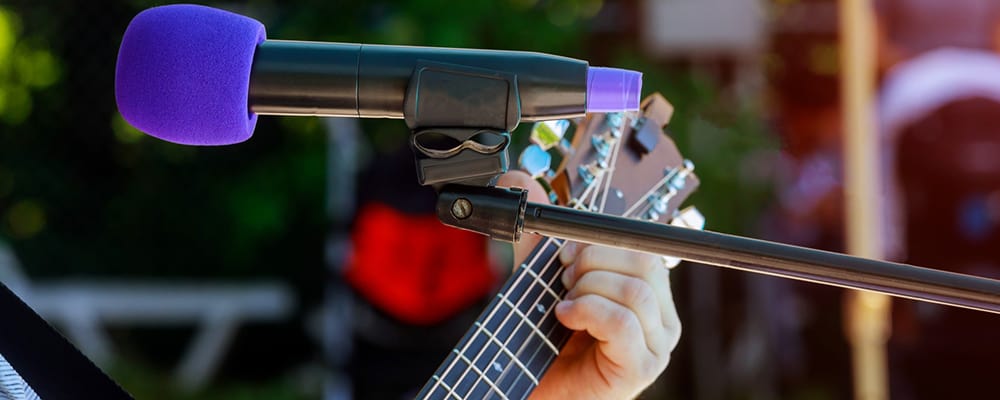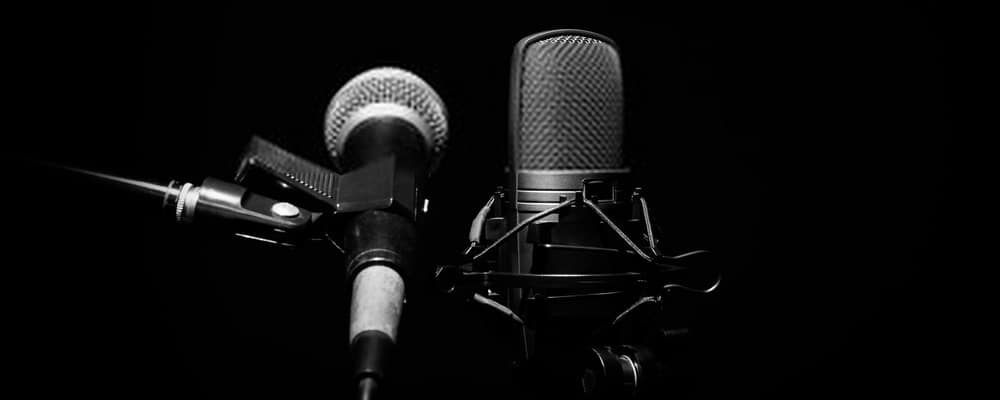Table of Contents
Whether you're looking to buy a new microphone or you're just curious about microphones, then it's handy to know what a condenser microphone is, as well as how it's different from a dynamic microphone. Both of these microphones are the most common in the music industry. We're going to answer all the essential questions about condenser microphones here. Let's begin by finding out precisely what a condenser microphone is and how it works.
What is a Condenser Microphone, and How Does it Work?
 Condenser microphones come in two different forms. There is a large-diaphragm condenser mic and a small-diaphragm condenser microphone, and both of these microphones work in the same way. Although, of course, one has a small diaphragm, and the other has a large diaphragm. Before we get onto the differences, let's look at the similarities between these two mics, and how all condenser microphones work.
Condenser microphones come in two different forms. There is a large-diaphragm condenser mic and a small-diaphragm condenser microphone, and both of these microphones work in the same way. Although, of course, one has a small diaphragm, and the other has a large diaphragm. Before we get onto the differences, let's look at the similarities between these two mics, and how all condenser microphones work.
Condenser microphones are sometimes referred to as capacitor microphones, as this was the old name used for them when they were first created back in 1916. This name was used because the way a condenser mic works is much the same as how a capacitor works. Condenser microphones have a capsule inside them, which is very similar to a capacitor.
The capsule that's inside a condenser microphone is made up of a diaphragm and a backplate. The diaphragm needs to be able to conduct electricity. For that reason, it will usually be made from or coated in a metal that can conduct electricity. The most commonly used material is 'gold-sputtered mylar,' as this is a lightweight, thin material that conducts electricity.
The diaphragm and the backplate are situated just inside the opening to the microphone. There's a small gap between the two. There needs to be some form of electric current passing in the gap between the diaphragm and backplate. This current will come from an external power supply. In modern condenser microphones, both batteries and phantom power are used as the external power supply.
Sound waves enter the microphone, causing the diaphragm to vibrate. The result of this is that the distance between the diaphragm and the backplate changes. And, through a process that might seem simple to a physicist and incomprehensible to the layman, this allows the sound waves to turn into an electrical signal, which can then be recorded or amplified after it passes through the condenser microphone's impedance converter.
These microphones are extremely sensitive to sound, thanks to the condenser design. Of course, as you can imagine from the design, they're also very fragile. They're built for particular uses. Now we're going to have a look at what you use these mics for.
What Are Condenser Mics Used For?
 As we've already learned, there are two different types of condenser microphones. They're each better suited to various tasks.
As we've already learned, there are two different types of condenser microphones. They're each better suited to various tasks.
Let's have a look at a large-diaphragm condenser mic first. A condenser mic with a large diaphragm is perfect to be used for vocals inside a recording studio. You can also use it for musical instruments that tend to produce low-end sound. The reason why recording artists and studio engineers love large-diaphragm condenser microphones so much is down to the natural sound quality they provide.
These mics are not suitable for the stage, though. And also, if you do intend to use a large-diaphragm condenser mic in the studio, then it's crucial to invest in a pop filter. That's because condenser mics are very sensitive, and that sensitivity means that they can pick up unwanted plosives. This is why you need a filter to ensure that the microphone records the vocals smoothly.
A condenser microphone that has a small diaphragm inside it is better suited to recording sound from instruments, such as an acoustic guitar or cello. Small-diaphragm condenser mics are known for capturing a vast frequency response. Of course, this wide frequency response is ideal for instruments, but it's not suitable for vocals, you'll want a large diaphragm condenser microphone for recording vocals.
So that you can get the very best sound quality from these microphones, you'll find that you can adjust the polar pattern. This means that you can find a polar pattern to suit your voice or your instrument, which is another reason why they're used in the recording studio.
What is the Difference Between a Dynamic Microphone and a Condenser Microphone?
When you look at microphones for music and singing, you'll find that you come across dynamic microphones as an alternative to condenser microphones.
 Firstly, let's look at the main differences between the two.
Firstly, let's look at the main differences between the two.
Dynamic microphones differ from condenser microphones firstly in their construction. Dynamic microphones are made to be used for live performances, which means that they are rugged, robust, and built to withstand wear and tear. These microphones are built to last. They're the most durable of all the microphones. Condenser microphones certainly can't be used in the same way, as they're made for the recording studio.
This is where we have another difference—sound quality. A condenser microphone is made to be used inside a recording studio. Therefore, it's fragile, and everything inside it is fragile too. A rock-n-roll singer can't swing it around their head, throw it around the stage, and expect it to work.
This is possible with dynamic microphones, but it comes at a cost. They don't sound as good as condensers. That isn't to say that they don't sound great - you just wouldn't want to record with a dynamic microphone, as they have a more narrow frequency response as compared with condensers. But you would always want to have a dynamic mic for any live performance.
Dynamic microphones differ from condenser microphones when it comes to power, too. As we've learned, condenser microphones require external power, either through phantom power or a battery. But you don't need phantom power for dynamic microphones, as they don't need to have a specific power supply.
If you're looking to buy a microphone, and you're not sure which of the two is the best for your needs, then you simply need to consider why you're using the microphone. Live performances, band practices, and spoken word live performances will probably be best-suited by a dynamic mic, as the narrow frequency range suits the human voice better in these circumstances.
If, however, you're looking to record your voice, especially your singing voice, then you'll want to take advantage of the better level of sound that you get from a condenser mic. If you're going to sound your best both on stage and in the recording studio, then you should invest in one microphone of each, as the sound is so different between the two that you can't use them interchangeably.
Summary
There you have it. Now you know precisely what a condenser microphone is and how it works. Through a capacitor design with a thin diaphragm and a backplate, sound waves move back and forth. Then, through an electrical supply, they can then be turned into an electrical signal. That then passes through an impedance converter so that it can then be recorded or amplified.
These microphones are perfect to be used in a recording studio because of how sensitive they are. There are two different types of them: one with a large diaphragm and the other with a small diaphragm. Each of these mics is better suited to recording different things, with the former suited to vocals and the latter better for instruments, such as acoustic guitars.
If there's one thing that condenser microphones shouldn't be used for, it's a live gig. They're just too fragile. For that, you want to find yourself a dynamic mic as they're much more robust.
However, they also don't offer the same frequency range as condenser mics, which is why they're not as suitable for use inside the recording studio. Always make sure that you buy the right microphone for the right purpose so that you can ensure the best sound quality at all times.
If you liked the article, please leave your feedback.
